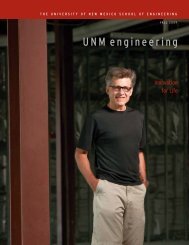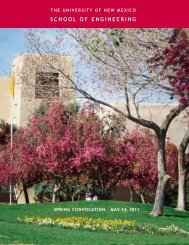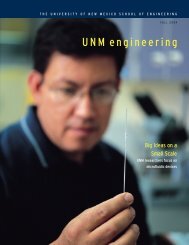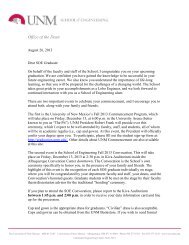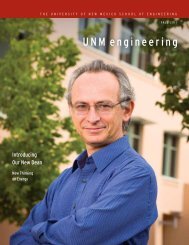UNM engineering - School of Engineering - University of New Mexico
UNM engineering - School of Engineering - University of New Mexico
UNM engineering - School of Engineering - University of New Mexico
Create successful ePaper yourself
Turn your PDF publications into a flip-book with our unique Google optimized e-Paper software.
Cracking the CodeCalhoun is not alone in his investigation. Terran Lane, assistant pr<strong>of</strong>essor <strong>of</strong>computer science, is also on the case. Lane, too, is investigating data fusionand is just starting to develop a sophisticated joint probability model that cancombine the different types <strong>of</strong> data.Lane is collaborating with Vince Clark, associate pr<strong>of</strong>essor <strong>of</strong> psychologyand scientific director <strong>of</strong> The MIND Institute, to study networks in the brain.“We’re trying to understand how different regions <strong>of</strong> the brain influence eachother and send messages to each other,” says Lane. “The goal is to untanglethe story and pull out a network.” Lane receives data directly from MINDresearchers and loads it on to computers in the Computer Science Department.Then comes the real challenge: the brain’s complexity and the immenseamount <strong>of</strong> data involved make teasing out relevant networks very difficult.“It’s as if I gave you a list <strong>of</strong> how many telephone calls enter and leave everybuilding on the <strong>UNM</strong> campus without telling you who they came from or wentto. Then, I asked you to tell me who called who,” explains Lane.Lane is cracking the code using powerful machine learning and statisticaltechniques. While his tools are decidedly high-tech, he’s based his processon a probability theorem, developed in the 18th century, called Bayes’ Rule.Using only a small fraction <strong>of</strong> the available data, s<strong>of</strong>tware based on Bayesiannetworks can scan the brain images for possible networks, learn about the dataas it goes, and use that information to improve the ongoing analysis process.Lane and senior doctoral student John Burge have created an in-house version<strong>of</strong> Bayesian network s<strong>of</strong>tware that includes anatomical and hierarchicalinformation about the brain’s structure as it evaluates the structural andtemporal data collected by MIND researchers. Lane filters results from thes<strong>of</strong>tware to improve the statistical confidence, then shares his findings withneuroscientists at The MIND Institute, who provide input and context on theresults. “It’s a feedback loop. We give them results and they give us backnew data and new questions to ask. Hopefully, from this process we’ll gainneuroscience consequences and computational consequences,” says Lane.A joint analysis was performed toidentify a component showing linkedelectrical changes as measured byelectroencephalography (EEG) andblood oxygenation changes asmeasured by functional magneticresonance imaging (fMRI) duringthe presentation <strong>of</strong> infrequent sounds,called an auditory oddball task. Thepink curve (below) provides informationabout ‘when’ and the orange coloredregions (above) provide informationabout ‘where’ the brain activity isdifferent in patients versus controls.Lane’s research, funded by a three-year grant from the National Institutes<strong>of</strong> Health, is at its midpoint. The team is currently evaluating some new networksextracted by the s<strong>of</strong>tware. “In the 20 years that I’ve been studying thehuman brain, I have watched the tools for data acquisition become far moresophisticated, while our methods <strong>of</strong> analysis have remained very simplistic. Weonly understand about 10 percent <strong>of</strong> the data we collect; the rest is obscuredby its complexity,” says Clark. “One <strong>of</strong> my goals for The MIND Institute is tosupport the work <strong>of</strong> scientists like Vince Calhoun and Terran Lane, who candevelop more sophisticated methods for analyzing brain data. Their algorithmshave already produced a flood <strong>of</strong> new insights into the kind <strong>of</strong> data that hasbeen available to us for years, but couldn’t be analyzed using available methods.”MICROVOLTS-1.0-0.500.51.01.5N1N2CONTROLPATIENTCOMPONENTP30 200 400TIME (MS)With clues, collaboration, and cutting-edge technology, <strong>UNM</strong>’s head detectivesare piecing together answers that will not only unlock the mysteries <strong>of</strong> themind, but could also improve millions <strong>of</strong> lives. d<strong>UNM</strong> <strong>Engineering</strong> 13



